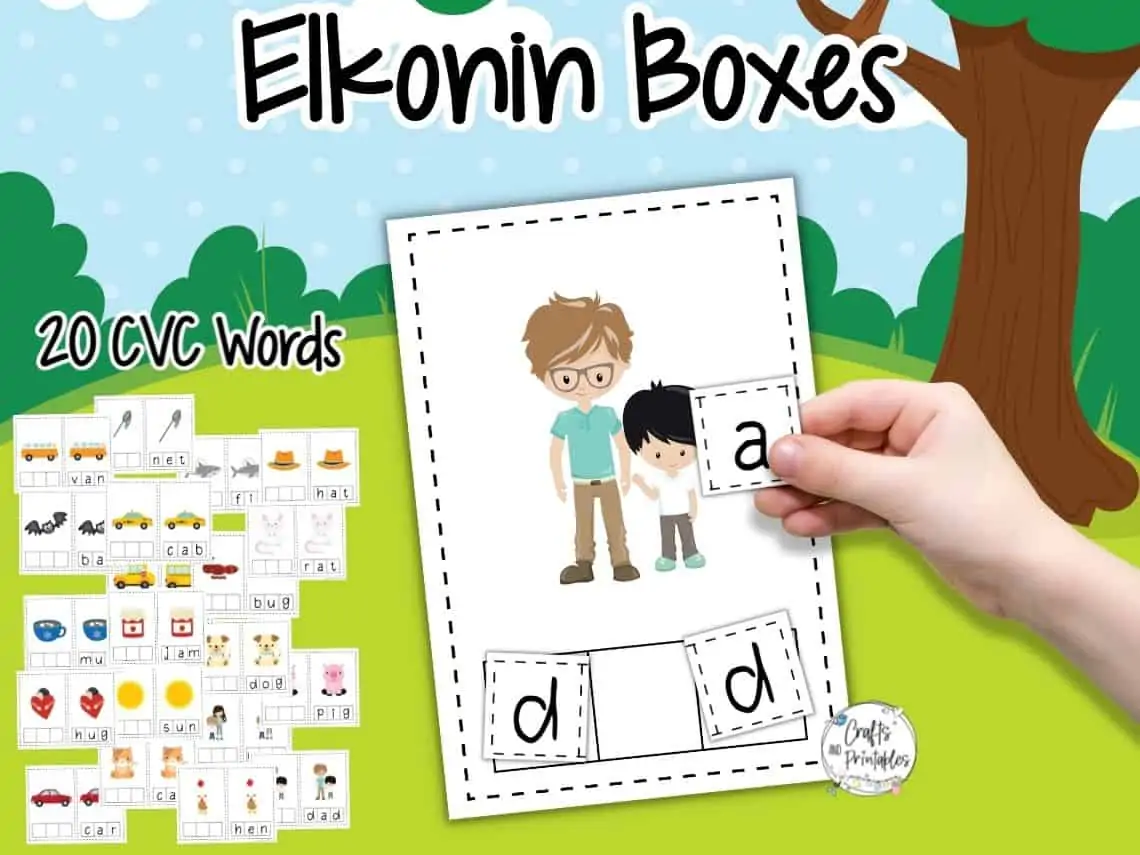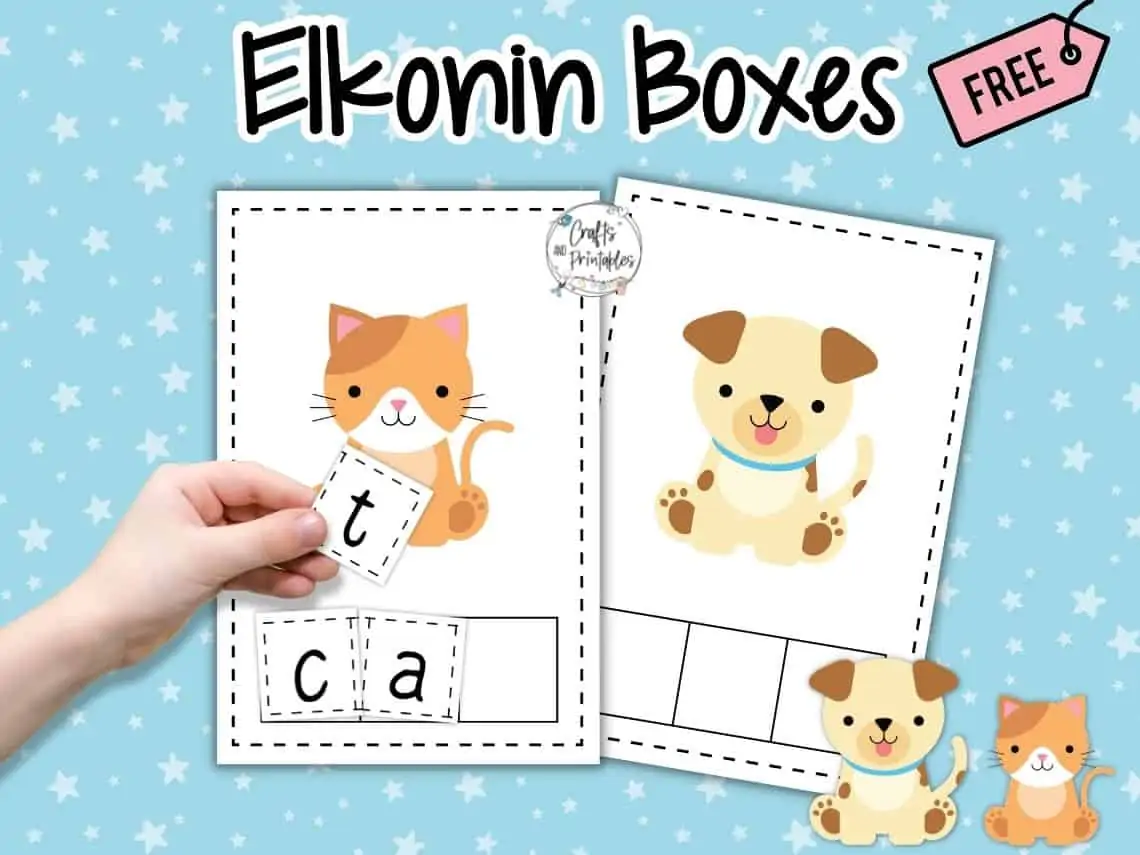Elkonin Boxes worksheets are one of the best ways to help children with developing their phonemic awareness.
This type of worksheet is designed to help children learn how to segment and blend sounds together, which will eventually help them read and spell words correctly.
This simple decoding strategy is a useful accessory in any program for reading, along with other reading tools like sight word memorization.
This article will explain Elkonin boxes and show you some printables you can use at home with your child!
What are Elkonin boxes?
Elkonin boxes were developed by Dr. Leonard Elkonin, who was a speech therapist and researcher.
He believed that if he could find a way to improve children’s reading skills, it would benefit all children.
His goal was to develop a method that would allow children to recognize sounds and then associate those sounds with letters and words.
Elkonin boxes (also known as sound boxes) are a research-based teaching strategy used in the early elementary grades to support students who may be struggling readers.
Teachers use Elkonin boxes to build and strengthen phonological awareness skills in young children.
Elkonin sound boxes require students to segment words into individual sounds or phonemes.
What is the difference between Elkonin boxes and sound boxes?
There is no difference between Elkonin boxes and sound boxes – they are just two names for the same strategy.
You may also see it spelled as “Elkin boxes”.
Why use Elkonin Boxes?
The key benefit of using Elkonin boxes is that they allow children to practice reading words by manipulating the sounds (phonemes) within those words.

This gives children a chance to see what each sound looks like, and makes it easier for them to recognize and pronounce new words.
Reading Intervention with Elkonin Boxes
Elkonin boxes provide a great visual scaffolding allowing pupils to blend without pausing between the letters and break words in phonemes.
It builds phonological and phonemical awareness and helps students visualize phonemes.
Colors for writing are especially helpful for students that struggle to read or write without error.
You can implement this strategy by laminating each sheet or placing them into a sheet protector and using a super fine dry erase marker.
Use Elkonin boxes as often as you can for your struggling readers and watch their reading fluency soar!
What is a Phoneme?
Most people have heard of the word “phoneme” but don’t know what it means.
A phoneme is a unit of sound that defines or distinguishes one word from another in language.
An example of phoneme might be c, h, th, p, and m in the words cat, hat, that, pat and mat.
There are 44 English phonemes, each representing either a distinct vowel or consonant sound.
Do Elkonin boxes help blending?
Yes! Elkonin boxes are excellent for building students’ phonological awareness, which is key to their understanding of how the English language works.
Blending is when you combine two or more letters to form a single sound.
For instance, some sounds may be represented by more than one letter (like ‘sh’ and ‘ch’).
This adds to their complexity as some words can have more than one way of being blended together.
Blending is a very important foundational skill in learning to read.
Elkonin boxes require children to segment words into individual sounds or phonemes so they can blend them together correctly.
Blending and segmenting words helps all struggling readers, especially those with dyslexia.
Can Elkonin boxes be used for phonics?
Yes! Phonics is the process of sounding out words.
It allows students to better understand how letters and letter combinations create individual sounds or phonemes (which are spoken sounds).
Elkonin boxes can be used for blending, segmenting, and building phonics skills.
Phonological awareness has been shown to improve reading skills, including word recognition and comprehension, even when teaching students who struggle with other literacy areas like reading fluency or writing mechanics.
Who would benefit from using Elkonin boxes?
Early readers aged 4-6 tend to develop phonological skills reinforced by Elkonin boxes, but this strategy can be used with any student who reads from level A to level G.
Any child who struggles with reading, spelling, or speaking would benefit from using Elkonin boxes..
Sound boxes can be used for CVC word studies and also to help reinforce initial blends, final blends and digraphing.

Teaching children using this strategy is best done in small groups or individual instruction.
Repeated practice will benefit both young students and older students in the classroom alike.
Why do Elkonin Boxes work?
The goal of Elkonin boxes is to give children a way to practice reading by identifying and manipulating sounds.
It works because it gives kids a fun activity they enjoy and can complete independently.
What are CVC words?
CVC words are three-letter words with one-syllable that have the pattern consonant-vowel-consonant. The middle vowel always has a short sound.
Some examples of CVC words might be bat, mom, mad, bug, sit and rat.
Learning to read and write CVC words is an excellent way for children, four years old or older in most cases, to improve their phonetic awareness.
CVC words are useful for improving children’s pronunciation, fluency and handwriting.
They can be especially helpful with younger ones who have trouble sounding out the sounds in unfamiliar word patterns.
How to use Elkonin boxes with your student?
Using an Elkonin sound box can help students build phonological awareness by breaking down words into smaller parts so they become easier to identify and manipulate.
You’ll need a set of Elkonin cards. (Check our free resources below for my Elkonin printable PDF!)
Use dry erase markers on laminated sheets or you can place the printouts in sheet protectors.
Use different color pens/markers for each syllable as well as one extra pen that is black instead of color to help students focus on the number of syllables in each word.
Elkonin Boxes Examples
There are a variety of different Elkonin Box worksheets that can be found online, and I’ve created this sample set of CVC Elkonin boxes with pictures for you to download and use for free.
Also called Phoneme Frames, these teach students to separate sounds and practice the skills of segmenting.
This printable bundle includes picture cards to practice literacy skills, as well as build phonemic awareness and phonics.
So why not give them a try? Your child may just surprise you with how quickly they improve!

This free printable sample includes 2 CVC words for young learners:
cat and dog
Each picture card comes with a blank version and a version that has the CVC word spelled out.
There is also a page of cut out letters so you can reuse this set over and over.
If you like this sample, we offer a larger Elkonin Box Printable Activity Set featuring these 20 CVC words:
mom, dad, cat, dog, car, bus, hat, pig, fin, bug, sun, rat, jam, van, bat, cab, hug, mug, net and hen
